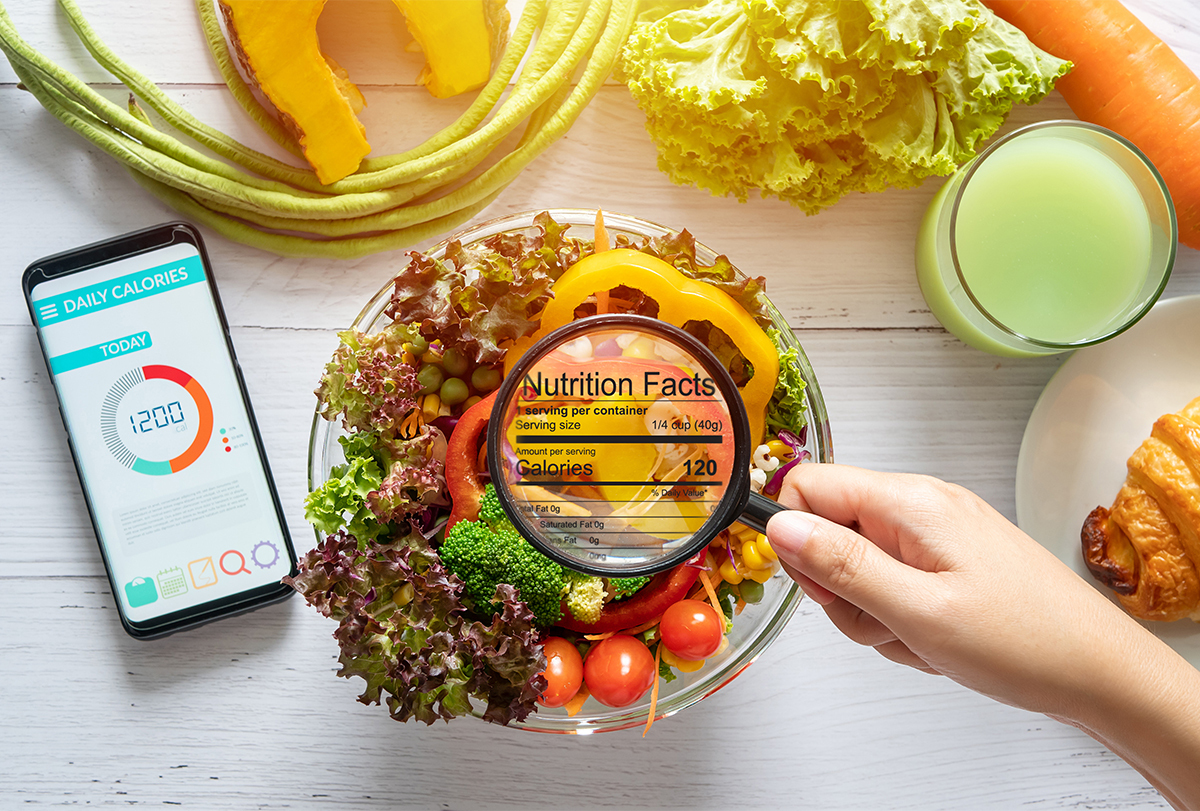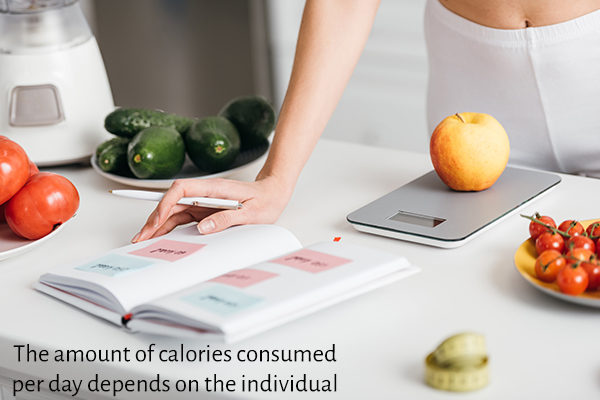In this article:
The most effective way to reduce calories is by using portion control and being mindful of calories consumed. Tracking calories is a pain, but it is the only way to know how much you are taking in a day.

Find out how many calories you usually consume in a day with mobile apps, and then limit their intake according to how much weight you need to lose.
Satiating Foods to Control Your Calorie Intake

The following food items are known to be effective in reducing hunger cravings and, subsequently your net calorie intake.
1. Protein-rich food
Studies show that out of the three macronutrients (fats, carbs, and protein), protein is the most filling. (1) This is because protein reduces your level of the hunger hormone “ghrelin.”
Choose lean protein sources such as meat, fish, poultry, soybeans, and eggs. Protein-rich snacks include Greek yogurt, string cheese, hard-boiled eggs, RXBARs, and cottage cheese, among others.
2. Dietary fiber
Fiber, roughage, or bulk is a nutrient found in plant foods that cannot be broken down by the digestive enzymes in the gastrointestinal tract. Thus, this indigestible substance remains unabsorbed in the body but still serves many important functions.
There are two types of plant-based natural fibers:
- Soluble
- Insoluble
Soluble fiber soaks in the water while passing through the digestive tract, softening the stool. Insoluble fiber adds bulk to the stool. Both these types of dietary fiber work together to promote easy bowel movement.
High-fiber foods provide volume and take longer for your body to digest, making you feel full longer. (2) Foods that contain fiber include whole grains, vegetables, beans, nuts, flaxseed, chia seeds, and fruits with skin. Adding non-starchy vegetables is a great way to add bulk and fiber to your food with little added calories.
ALSO READ: 5 Health Problems Linked to Fiber Deficiency
3. Fats
Fats are high-energy-dense foods, meaning they provide a lot of calories for a small amount. Including healthy monounsaturated and polyunsaturated fats in your diet not only is great for heart health but can also curb hunger pangs.
Some popular foods that are replete with such healthy fats include avocados, nuts, seeds, and oils such as avocado or olive oil. Just be aware of serving sizes as a handful of nuts provides plenty of calories.
ALSO READ: Which Fats Are Good and Bad for Your Health?
Lifestyle Changes to Manage Your Calorie Consumption

1. Do not drink your calories
Reduce the intake of sugary beverages such as soda, juice, and Gatorade! One 12-oz can of coke contains 140 calories and 39 grams of added sugar. These empty calories add up throughout the day and provide no nutritional value.
Instead, drink more water or all-natural flavored water seltzers! My personal favorite seltzer is bubbly. If you do not like seltzer, add fruit to your water to give it a natural flavor.
2. Consume low-energy-dense foods
Add low-energy-dense foods to meals to add bulk and make you feel full longer! Adding non-starchy vegetables to meals can make it feel like you are eating more and provide fiber to your diet without a lot of added calories.
A tip is to keep roasted vegetables or a big side salad full of veggies in the refrigerator. This way, they are ready to go, and you can easily add them to meals throughout the day.
3. Cut out processed snacks as much as possible
Instead of munching on processed foods that add little nutrients to the body, pick fruit, vegetables with hummus, almonds, or protein-filled snacks that will provide satiety.
ALSO READ: What Food Additives Are Bad for You?
4. Pick whole grains whenever possible
Whole grains contain more protein, fiber, and B vitamins than refined grains. (3) The added protein and fiber will curb snack cravings and hold you over for your next meal.
5. Be aware of creamer and sugars in coffee
One tablespoon of sugar contains approximately 50 calories! That’s not including the creamers and syrups most drinks contain. To cut back, top your coffee off with oat milk, unsweetened almond milk, or skim milk instead.
6. Use less sauce
Condiments such as barbecue sauce, mayonnaise, ketchup, and salad dressings can be loaded with excess saturated fat and calories. For example, 1 tablespoon of mayonnaise can add an extra 57 calories to your meal. Cut back on the sauces and use seasonings instead.
7. Use smaller plates
Using a smaller plate is a simple trick to help practice portion control.
Go a step farther and use the USDA MyPlate guidelines, which suggest filling half of your plate with non-starchy vegetables and fruit, one-fourth with a lean protein source, and one-fourth with whole grain. (4)
8. Drink water before and between meals
Drinking water before your meal can help you feel more satisfied. Sometimes, your body thinks you are hungry, but in reality, you are thirsty. When you are unsure, I suggest sipping on water and going for a walk. If you are still hungry, then eat something.
How Many Calories Should Be Burned and Consumed During the Day?

The amount of calories consumed per day depends on the individual. Many factors go into determining calorie intake, including sex, weight, height, age, and activity.
To find the right amount for you, I recommend seeing a registered dietitian or using a free, reliable app or calorie calculator on the web. If you are aiming for weight loss, then you need to burn more calories than you consume in a day.
In general, the ideal rate of calorie intake and calorie exhaustion can differ from person to person, depending upon their body composition and individual needs.
ALSO READ: 7 Easy Hacks to Reduce Calorie Intake
Relationship Between Cutting Calories and Weight Loss
Cutting calories will lead to weight loss. (5) If you are consuming fewer calories than you burn, you will lose weight and vice versa. However, it is important not to cut it too much so you can receive the proper nutrients your body needs to function.
The Comparative Importance of Calorie Reduction and Exercise for Weight Loss
Calorie reduction promotes weight loss more effectively than increasing exercise does. It is easier for most people to cut calories faster through dietary changes than to burn calories through increased exercise.
When you consume much more energy than what your body needs, the excess will turn into fat. If you exercise a lot but continue consuming extra energy or calories, you will still gain fat.
For my clients that can exercise, I like to combine the two measures for faster results. Exercise combined with calorie reduction will aid in weight loss as you will be burning more calories while simultaneously building muscle! Studies show exercise can also help you maintain your weight loss for longer. (6)(7)
Is Dieting the Best Way to Reduce Calorie Intake?
I am a firm believer in practicing mindful eating and eating in moderation rather than restricting the diet and starving the body. I describe this as a lifestyle change more than dieting.
Practicing healthy dieting habits will lead to weight loss for a lifetime, while fad diets are a temporary fix. Most of my clients that participate in fad diets tend to regain the weight when they go back to their normal diet.
ALSO READ:
- How Important Is Dieting for Weight Loss?
- The Art of Dieting, Survey by 37 Nutritionists and Dietitians
Should One Avoid Fruit Juices for Better Calorie Control?
When buying fruit juice, it is super important to look at the ingredients label. Many juices contain hidden calories, added sugar, and preservatives.
Most packaged juices strip the natural fiber in fruit and increase the sugar content to make it taste better.
I always recommend grabbing real fruit instead! Eating whole fruit will ensure you are gaining the benefits of the added fiber, which helps control blood sugar, lower cholesterol, and fight off hunger. (8)(9)
If you love fruit juice or are a picky eater, I recommend home-pressed juices or those with no added sugar. The only ingredients should be fruit.
Final Word
When first starting to reduce calories, focus on little dietary changes that will help reduce your calorie intake, such as quitting sugary beverages, cutting back on sugar in your morning coffee, eating whole grains, cutting back on red meat, and reducing the amount of processed snacks and sweets you consume.
These little changes will turn into weight loss and will become healthy lifelong habits.
- Was this article helpful?
- YES, THANKS!NOT REALLY


